Improving the Accuracy of Water Storage Anomaly Trends Based on a New Statistical Correction Hydrological Model Weighting Method
Abstract
:1. Introduction
2. Materials and Method
2.1. Study Area
2.2. Data
2.2.1. GRACE Mascon
2.2.2. Hydrological Models
2.3. Establishment of the NSCHMW Method
- Estimation of TWSA based on hydrological models;
- 2.
- Assignment of weights based on statistical indicators.
- 3.
- Weighting TWSA based on weights.
3. Results
3.1. TWSA Derived from GRACE Mascon
3.2. Evaluation of TWSA from Hydrological Models
3.2.1. TWSA Trends
3.2.2. SMSA Trends
3.2.3. GWSA Trends
3.3. Analyzing Water Storage Changes in Plains and Mountains
3.4. Model Uncertainty
4. Discussion
4.1. Correlation Coefficient of TWSA in Different Periods
4.2. Analysis of Driving Factors of TWSA in HRB
4.2.1. Correlative Coefficient of TWSA in Different Periods
4.2.2. Reasons for Over/Underestimated the TWSA from GRACE and Models
4.2.3. Drivers of Groundwater Depletion
5. Conclusions
- This paper develops the NSCHMW method to solve the uncertainty between the hydrological models and GRACE, which gives weight to the hydrological models by combining multi-source models (WGHM and PCR-GLOBWB) simulation results. Compared with a single model, the NSCHMW method fully considers the accuracy and consistency of hydrological models and GRACE data, and it can effectively improve the accuracy of TWSA trends calculated by hydrological models.
- The NSCHMW method is verified in HRB. In terms of spatial distribution, the Merge result calculated by the NSCHMW method is more consistent with GRACE-derived TWSA. As for both WGHM and PCR-GLOBWB, there are insufficient and excessive signal simulations in some regions. The results manifest that two GRACE mascon data enjoy the favorable agreement in TWSA by analyzing spatiotemporal variations; consequently, the average of JPL and CSR can utilize to assist the improvement of hydrological models. According to the estimation of GRACE, the TWSA indicates a pronounced decreasing trend at a rate of −15.7 ± 0.7 mm/year in the whole HRB. The performances of hydrological models in mountains (−14.2 ± 0.7 mm/year) and plains (−17.2 ± 1.1 mm/year) are also analyzed in more detail through the comparison of time-series curves, as well as the results show a faster decline in plains and a slower decline in mountains. The decreasing TWSA trends in mountains are attributed to the climate variability, conversely, that in plains are mostly due to overdrawing of groundwater caused by irrigation. Additionally, contributions of GWSA trends (−15.2 ± 0.9 mm/year) to TWSA trends are far greater than SMSA trends (−0.4 ± 0.6 mm/year), respectively.
- In terms of the reliability of models, first and foremost, it is classified as dry years from 2003 to 2009 and wet years from 2010 to 2014 according to the Water Resources Bulletin. The correlation coefficient between hydrological models and GRACE are high from 2003 to 2009 (r = 0.68~0.89), while low from 2010 to 2014 (r = 0.38~0.74). It implies that precipitation is one of the essential factors affecting the changes in water storage. There is one more point that the TWSA trends from two GHWRMs are most consistent with GRACE, which hints that WGHM and PCR-GLOBWB take human effects into account and calibrate it, while the LSMs (Noah, VIC, CLSM2.1, CLSM2.0, and CLM) underestimate the TWSA trends, although they are accurate with SMSA simulations. Furthermore, the model structure plays an important role in uncertainties from different hydrological models, with the overestimation of GHWRMs and the underestimation of LSMs in TWSA trends. GHWRMs pay attention to irrigation, while LSMs focus on soil moisture. This result is remarkable considering that the CLM displays TWSA trends opposite to GRACE in northern HRB due to large errors caused by model uncertainty, so it infers that CLM is not applicable in HRB.
- Afterward, SMSA trends are basically in a long-term stable, while GWSA trends continued to decline due to the human activities, of which spatial-temporal patterns are similar to TWSA. It also proves the necessity of the South-North Water Diversion project, which can alleviate the rate of groundwater consumption. The groundwater recovery is projected to balance by the South-North Water Diversion project in the coming decade due to subjoin diverted water and the stricter policies on reducing agricultural water use, replacement of groundwater withdrawal with diverted water for domestic and industrial use. More reliable hydrological models will be realized in HRB by better considering GWSA in the future.
- Eventually, compared with the traditional method, the NSCHMW method can effectively improve the RMSE, NES, and r of hydrological models, of which RMSE decreases by 3–96%, NSE increases by 35–282%, and r increases by 1–255%, respectively. On the time series curve, the Merge is more consistent with the TWSA trend of GRACE inversion than single models. This paper emphasizes the importance of evaluating the applicability of hydrological models in HRB owing to the deficiencies of the simulation process. Currently, the NSCHMW method largely relies on the consistency between hydrological models and GRACE, while it still has achieved good results on the grid-scale.
Supplementary Materials
Author Contributions
Funding
Institutional Review Board Statement
Informed Consent Statement
Data Availability Statement
Acknowledgments
Conflicts of Interest
References
- Feng, W.; Zhong, M.; Lemoine, J.-M.; Biancale, R.; Hsu, H.-T.; Xia, J. Evaluation of groundwater depletion in North China using the Gravity Recovery and Climate Experiment (GRACE) data and ground-based measurements. Water Resour. Res. 2013, 49, 2110–2118. [Google Scholar] [CrossRef]
- Guo, Y.; Shen, Y. Quantifying water and energy budgets and the impacts of climatic and human factors in the Haihe River Basin, China: 1. Model and validation. J. Hydrol. 2015, 528, 206–216. [Google Scholar] [CrossRef]
- Zhong, M.; Duan, J.; Xu, H.; Peng, P.; Yan, H.; Zhu, Y. Trend of China land water storage redistribution at medi- and large-spatial scales in recent five years by satellite gravity observations. Sci. Bull. 2009, 54, 816–821. [Google Scholar] [CrossRef] [Green Version]
- Gong, H.; Pan, Y.; Zheng, L.; Li, X.; Zhu, L.; Zhang, C.; Huang, Z.; Li, Z.; Wang, H.; Zhou, C. Long-term groundwater storage changes and land subsidence development in the North China Plain (1971–2015). Hydrogeol. J. 2018, 26, 1417–1427. [Google Scholar] [CrossRef] [Green Version]
- Liang, H.; Qin, W.; Hu, K.; Tao, H.; Li, B. Modelling groundwater level dynamics under different cropping systems and developing groundwater neutral systems in the North China Plain. Agric. Water Manag. 2019, 213, 732–741. [Google Scholar] [CrossRef]
- Long, D.; Pan, Y.; Zhou, J.; Chen, Y.; Hou, X.; Hong, Y.; Scanlon, B.R.; Longuevergne, L. Global analysis of spatiotemporal variability in merged total water storage changes using multiple GRACE products and global hydrological models. Remote Sens. Environ. 2017, 192, 198–216. [Google Scholar] [CrossRef]
- Tapley, B.D.; Bettadpur, S.; Ries, J.C.; Thompson, P.F.; Watkins, M.M. GRACE Measurements of Mass Variability in the Earth System. Science 2004, 305, 503–505. [Google Scholar] [CrossRef] [Green Version]
- Swenson, S.; Wahr, J.; Milly, P.C.D. Estimated accuracies of regional water storage variations inferred from the Gravity Re-covery and Climate Experiment (GRACE). Water Resour. Res. 2003, 39, 1223. [Google Scholar] [CrossRef]
- Yin, W.; Han, S.-C.; Zheng, W.; Yeo, I.-Y.; Hu, L.; Tangdamrongsub, N.; Ghobadi-Far, K. Improved water storage estimates within the North China Plain by assimilating GRACE data into the CABLE model. J. Hydrol. 2020, 590, 125348. [Google Scholar] [CrossRef]
- Frappart, F.; Ramillien, G. Monitoring Groundwater Storage Changes Using the Gravity Recovery and Climate Experiment (GRACE) Satellite Mission: A Review. Remote Sens. 2018, 10, 829. [Google Scholar] [CrossRef] [Green Version]
- Yin, W.; Li, T.; Zheng, W.; Hu, L.; Han, S.-C.; Tangdamrongsub, N.; Šprlák, M.; Huang, Z. Improving regional groundwater storage estimates from GRACE and global hydrological models over Tasmania, Australia. Hydrogeol. J. 2020, 28, 1809–1825. [Google Scholar] [CrossRef]
- Long, D.; Shen, Y.; Sun, A.; Hong, Y.; Longuevergne, L.; Yang, Y.; Li, B.; Chen, L. Drought and flood monitoring for a large karst plateau in Southwest China using extended GRACE data. Remote Sens. Environ. 2014, 155, 145–160. [Google Scholar] [CrossRef]
- Felfelani, F.; Wada, Y.; Longuevergne, L.; Pokhrel, Y. Natural and human-induced terrestrial water storage change: A global analysis using hydrological models and GRACE. J. Hydrol. 2017, 553, 105–118. [Google Scholar] [CrossRef] [Green Version]
- Rodell, M.; Houser, P.R.; Jambor, U.; Gottschalck, J.; Mitchell, K.; Meng, C.-J.; Arsenault, K.; Cosgrove, B.; Radakovich, J.; Bosilovich, M.; et al. The Global Land Data Assimilation System. Bull. Am. Meteorol. Soc. 2004, 85, 381–394. [Google Scholar] [CrossRef] [Green Version]
- Alcamo, J.; Döll, P.; Henrichs, T.; Kaspar, F.; Lehner, B.; Rösch, T.; Siebert, S. Development and testing of the WaterGAP 2 global model of water use and availability. Hydrol. Sci. J. 2003, 48, 317–337. [Google Scholar] [CrossRef]
- Müller Schmied, H.; Eisner, S.; Franz, D.; Wattenbach, M.; Portmann, F.T.; Flörke, M.; Döll, P. Sensitivity of simulated glob-al-scale freshwater fluxes and storages to input data, hydrological model structure, human water use and calibration. Hydrol. Earth Syst. Sci. 2014, 18, 3511–3538. [Google Scholar] [CrossRef] [Green Version]
- Van Beek, L.; Bierkens, M.F. The Global Hydrological Model PCR-GLOBWB: Conceptualization, Parameterization and Veri-Fication; Utrecht University: Utrecht, The Netherlands, 2009. [Google Scholar]
- Sutanudjaja, E.H.; van Beek, R.; Wanders, N.; Wada, Y.; Bosmans, J.H.C.; Drost, N.; van der Ent, R.J.; de Graaf, I.E.M.; Hoch, J.M.; de Jong, K.; et al. PCR-GLOBWB 2: A 5 arcmin global hydrological and water resources model. Geosci. Model Dev. 2018, 11, 2429–2453. [Google Scholar] [CrossRef] [Green Version]
- Zhang, L.; Dobslaw, H.; Stacke, T.; Güntner, A.; Dill, R.; Thomas, M. Validation of terrestrial water storage variations as simulated by different global numerical models with GRACE satellite observations. Hydrol. Earth Syst. Sci. 2017, 21, 821–837. [Google Scholar] [CrossRef] [Green Version]
- Scanlon, B.R.; Zhang, Z.; Save, H.; Sun, A.; Schmied, H.M.; van Beek, L.P.H.; Wiese, D.N.; Wada, Y.; Long, D.; Reedy, R.C.; et al. Global models underestimate large decadal declining and rising water storage trends relative to GRACE satellite data. Proc. Natl. Acad. Sci. USA 2018, 115, E1080–E1089. [Google Scholar] [CrossRef] [Green Version]
- Liu, R.; She, D.; Li, M.; Wang, T. Using satellite observations to assess applicability of GLDAS and WGHM hydrological model. J. Wuhan Univ. 2019, 44, 1596–1604. [Google Scholar]
- Xu, L.; Chen, N.; Zhang, X.; Chen, Z. Spatiotemporal Changes in China’s Terrestrial Water Storage From GRACE Satellites and Its Possible Drivers. J. Geophys. Res. Atmos. 2019, 124, 11976–11993. [Google Scholar] [CrossRef]
- Yang, X.; Tian, S.; Feng, W.; Ran, J.; You, W.; Jiang, Z.; Gong, X. Spatio-Temporal Evaluation of Water Storage Trends from Hydrological Models over Australia Using GRACE Mascon Solutions. Remote Sens. 2020, 12, 3578. [Google Scholar] [CrossRef]
- Huang, Z.; Pan, Y.; Gong, H.; Yeh, P.J.F.; Li, X.; Zhou, D.; Zhao, W. Subregional-scale groundwater depletion detected by GRACE for both shallow and deep aquifers in North China Plain. Geophys. Res. Lett. 2015, 42, 1791–1799. [Google Scholar] [CrossRef]
- Zhang, C.; Duan, Q.; Yeh, P.J.; Pan, Y.; Gong, H.; Moradkhani, H.; Gong, W.; Lei, X.; Liao, W.; Xu, L.; et al. Sub-regional groundwater storage recovery in North China Plain after the South-to-North water diversion project. J. Hydrol. 2021, 597, 845. [Google Scholar] [CrossRef]
- Ren, Y.; Pan, Y.; Gong, H. Haihe Basin groundwater reserves space trend analysis. J. Cap. Norm. Univ. 2014, 35, 89–98. (In Chinese) [Google Scholar]
- Wang, J.; Jiang, D.; Huang, Y.; Wang, H. Drought Analysis of the Haihe River Basin Based on GRACE Terrestrial Water Storage. Sci. World J. 2014, 2014, 1–10. [Google Scholar] [CrossRef] [Green Version]
- Pan, Y.; Zhang, C.; Gong, H.; Yeh, P.J.-F.; Shen, Y.; Guo, Y.; Huang, Z.; Li, X. Detection of human-induced evapotranspiration using GRACE satellite observations in the Haihe River basin of China. Geophys. Res. Lett. 2017, 44, 190–199. [Google Scholar] [CrossRef]
- Ran, Q.; Pan, Y.; Wang, Y.; Chen, L.; Xu, H. Estimation of annual groundwater exploitation in Haihe River Basin by use of GRACE satellite data. Adv. Sci. Technol. Water Resour. 2013, 33, 42–46. (In Chinese) [Google Scholar]
- Rodell, M.; Famiglietti, J.S.; Wiese, D.N.; Reager, J.T.; Beaudoing, H.K.; Landerer, F.W.; Lo, M.-H. Emerging trends in global freshwater availability. Nature 2018, 557, 651–659. [Google Scholar] [CrossRef]
- Rodell, M.; Chao, B.F.; Au, A.Y.; Kimball, J.S.; McDonald, K.C. Global Biomass Variation and Its Geodynamic Effects: 1982–1998. Earth Interact. 2005, 9, 1–19. [Google Scholar] [CrossRef] [Green Version]
- Humphrey, V.; Gudmundsson, L.; Seneviratne, S. Assessing Global Water Storage Variability from GRACE: Trends, Seasonal Cycle, Subseasonal Anomalies and Extremes. Surv. Geophys. 2016, 37, 357–395. [Google Scholar] [CrossRef] [Green Version]
- David, F.N. Rank Correlation Methods. Br. J. Stat. Psychol. 1950, 9, 68. [Google Scholar] [CrossRef]
- Sakumura, C.; Bettadpur, S.; Bruinsma, S.L. Ensemble prediction and intercomparison analysis of GRACE time-variable gravity field models. Geophys. Res. Lett. 2014, 41, 1389–1397. [Google Scholar] [CrossRef]
- Nash, J.E.; Sutcliffe, J.V. River flow forecasting through conceptual models part I—A discussion of principles. J. Hydrol. 1970, 11, 109–128. [Google Scholar] [CrossRef]
- Chai, T.; Draxler, R.R. Root mean square error (RMSE) or mean absolute error (MAE)?—Arguments against avoiding RMSE in the literature. Geosci. Model Dev. 2014, 7, 1247–1250. [Google Scholar] [CrossRef] [Green Version]
- Rodgers, J.L.; Nicewander, W.A. Thirteen ways to look at the correlation coefficient. Am. Stat. 1988, 42, 59–66. [Google Scholar] [CrossRef]
- Han, P. Status quo of groundwater development and utilization in Haihe River basin and its management. Haihe Water Resour. 2015, 39, 1–5. (In Chinese) [Google Scholar]
- Watkins, M.M.; Wiese, D.N.; Yuan, D.-N.; Boening, C.; Landerer, F. Improved methods for observing Earth’s time variable mass distribution with GRACE using spherical cap mascons. J. Geophys. Res. Solid Earth 2015, 120, 2648–2671. [Google Scholar] [CrossRef]
- Wiese, D.N.; Landerer, F.W.; Watkins, M.M. Quantifying and reducing leakage errors in the JPL RL05M GRACE mascon solution. Water Resour. Res. 2016, 52, 7490–7502. [Google Scholar] [CrossRef]
- Save, H.; Bettadpur, S.; Tapley, B. High-resolution CSR GRACE RL05 mascons. J. Geophys. Res. Solid Earth 2016, 121, 7547–7569. [Google Scholar] [CrossRef]
- Li, B.; Rodell, M.; Sheffield, J.; Wood, E.; Sutanudjaja, E. Long-term, non-anthropogenic groundwater storage changes sim-ulated by three global-scale hydrological models. Sci. Rep. 2019, 9, 1–18. [Google Scholar]
- Oleson, K.W.; Lawrence, D.M.; Bonan, G.B. Technical Description of Version 4.5 of the Community Land Model (CLM). Ncar Tech. Note NCAR/TN-503 + STR; National Center for Atmospheric Research: Boulder, CO, USA, 2013. [Google Scholar]
- Tao, S.Y.; Wei, J.; Sun, J.H.; Zhao, S.X. The severe drought in East China during November, December and January 2008–2009. Meteorol. Appl. 2009, 35, 3–10. [Google Scholar]
- Gao, H.; Yang, S. A severe drought event in northern China in winter 2008–2009 and the possible influences of La Niña and Tibetan Plateau. J. Geophys. Res. Space Phys. 2009, 114, 455–475. [Google Scholar] [CrossRef]
- Chi, P.; Zhang, S.T. Analysis on the causes of the widespread drought in North China. J. Anhui Agric. Sci. 2011, 39, 411–464, 466. [Google Scholar]
- Shen, X.L.; Zhu, C.W.; Li, M. Possible causes of persistent drought event in North China during the cold season of 2010. Chin. J. Atoms. 2012, 36, 1123–1134. [Google Scholar]
- Long, D.; Yang, W.; Scanlon, B.R.; Zhao, J.; Liu, D.; Burek, P.; Pan, Y.; You, L.; Wada, Y. South-to-North Water Diversion stabilizing Beijing’s groundwater levels. Nat. Commun. 2020, 11, 1–10. [Google Scholar] [CrossRef]
- Tian, S.; Tregoning, P.; Renzullo, L.J.; van Dijk, A.I.J.M.; Walker, J.P.; Pauwels, V.R.N.; Allgeyer, S. Improved water balance component estimates through joint assimilation of GRACE water storage and SMOS soil moisture retrievals. Water Resour. Res. 2017, 53, 1820–1840. [Google Scholar] [CrossRef]
- Kerr, Y.; Al-Yaari, A.; Rodriguez-Fernandez, N.J.; Parrens, M.; Molero, B.; Leroux, D.; Bircher, S.; Mahmoodi, A.; Mialon, A.; Richaume, P.; et al. Overview of SMOS performance in terms of global soil moisture monitoring after six years in operation. Remote Sens. Environ. 2016, 180, 40–63. [Google Scholar] [CrossRef]
- Wang, J.; Song, C.; Reager, J.T.; Yao, F.; Famiglietti, J.; Sheng, Y.; Macdonald, G.M.; Brun, F.; Schmied, H.M.; Marston, R.A.; et al. Recent global decline in endorheic basin water storages. Nat. Geosci. 2018, 11, 926–932. [Google Scholar] [CrossRef] [PubMed] [Green Version]
- Rodell, M.; Velicogna, I.; Famiglietti, J.S. Satellite-based estimates of groundwater depletion in India. Nature 2009, 460, 999–1002. [Google Scholar] [CrossRef] [PubMed] [Green Version]
- Döll, P.; Schmied, H.M.; Schuh, C.; Portmann, F.T.; Eicker, A. Global-scale assessment of groundwater depletion and related groundwater abstractions: Combining hydrological modeling with information from well observations and GRACE satellites. Water Resour. Res. 2014, 50, 5698–5720. [Google Scholar] [CrossRef]
- Guo, Y.; Shen, Y. Quantifying water and energy budgets and the impacts of climatic and human factors in the Haihe River Basin, China: 2. Trends and implications to water resources. J. Hydrol. 2015, 527, 251–261. [Google Scholar] [CrossRef]
- Cao, G.; Zheng, C.; Scanlon, B.R.; Liu, J.; Li, W. Use of flow modeling to assess sustainability of groundwater resources in the North China Plain. Water Resour. Res. 2013, 49, 159–175. [Google Scholar] [CrossRef]
- Tang, Q.; Zhang, X.; Tang, Y. Anthropogenic impacts on mass change in North China. Geophys. Res. Lett. 2013, 40, 3924–3928. [Google Scholar] [CrossRef]
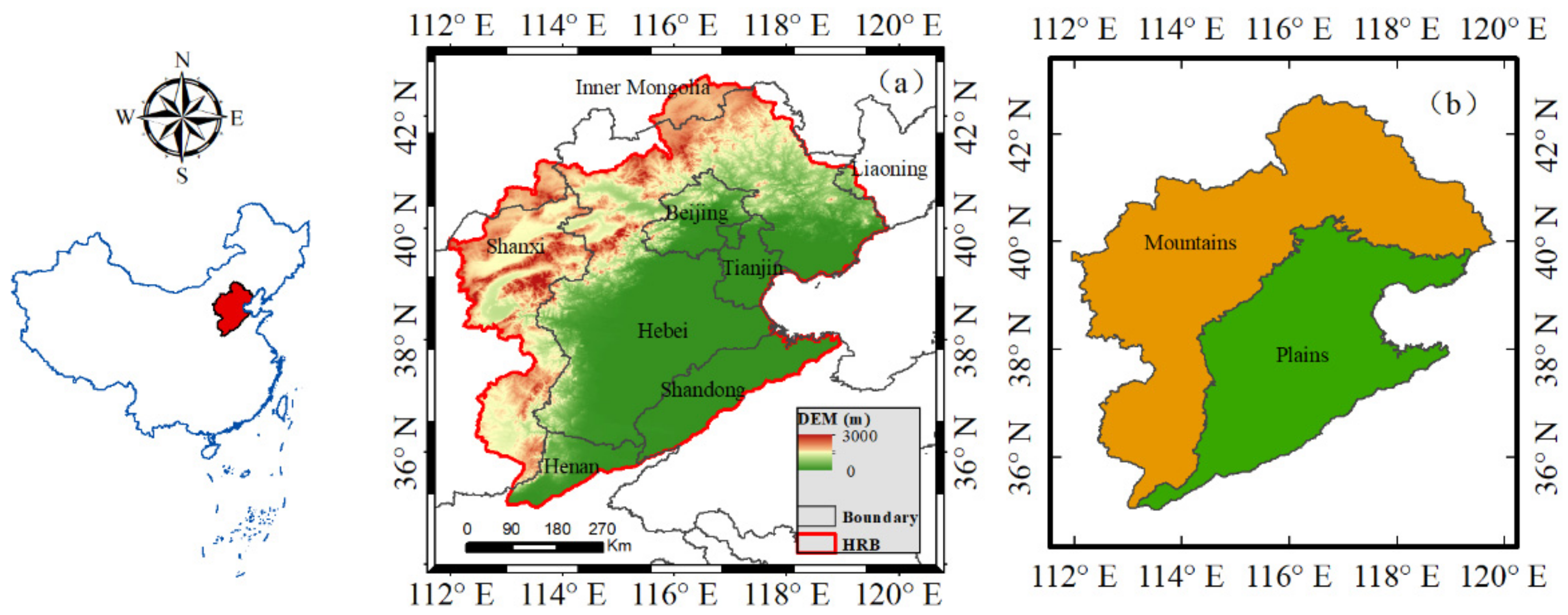

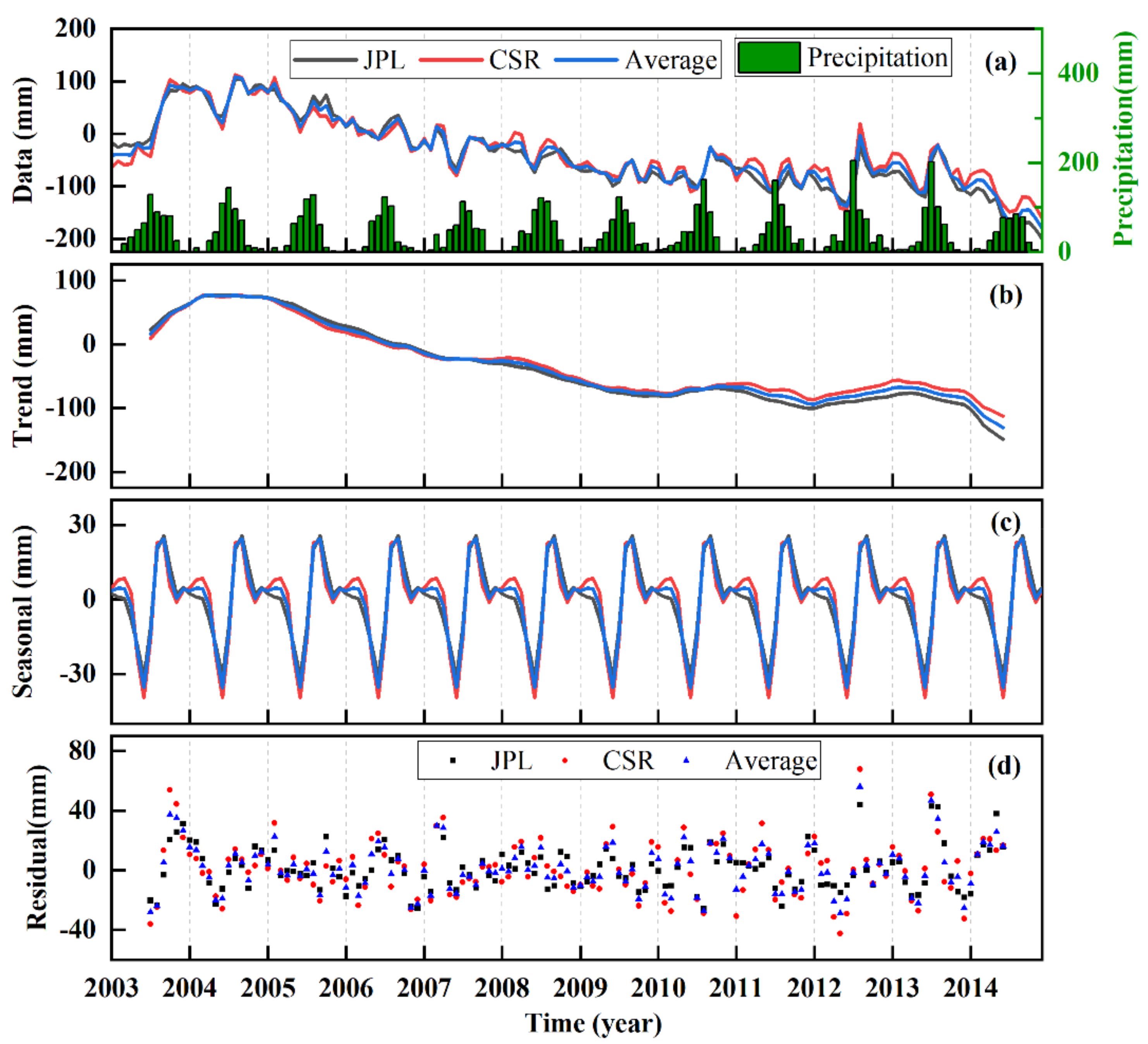
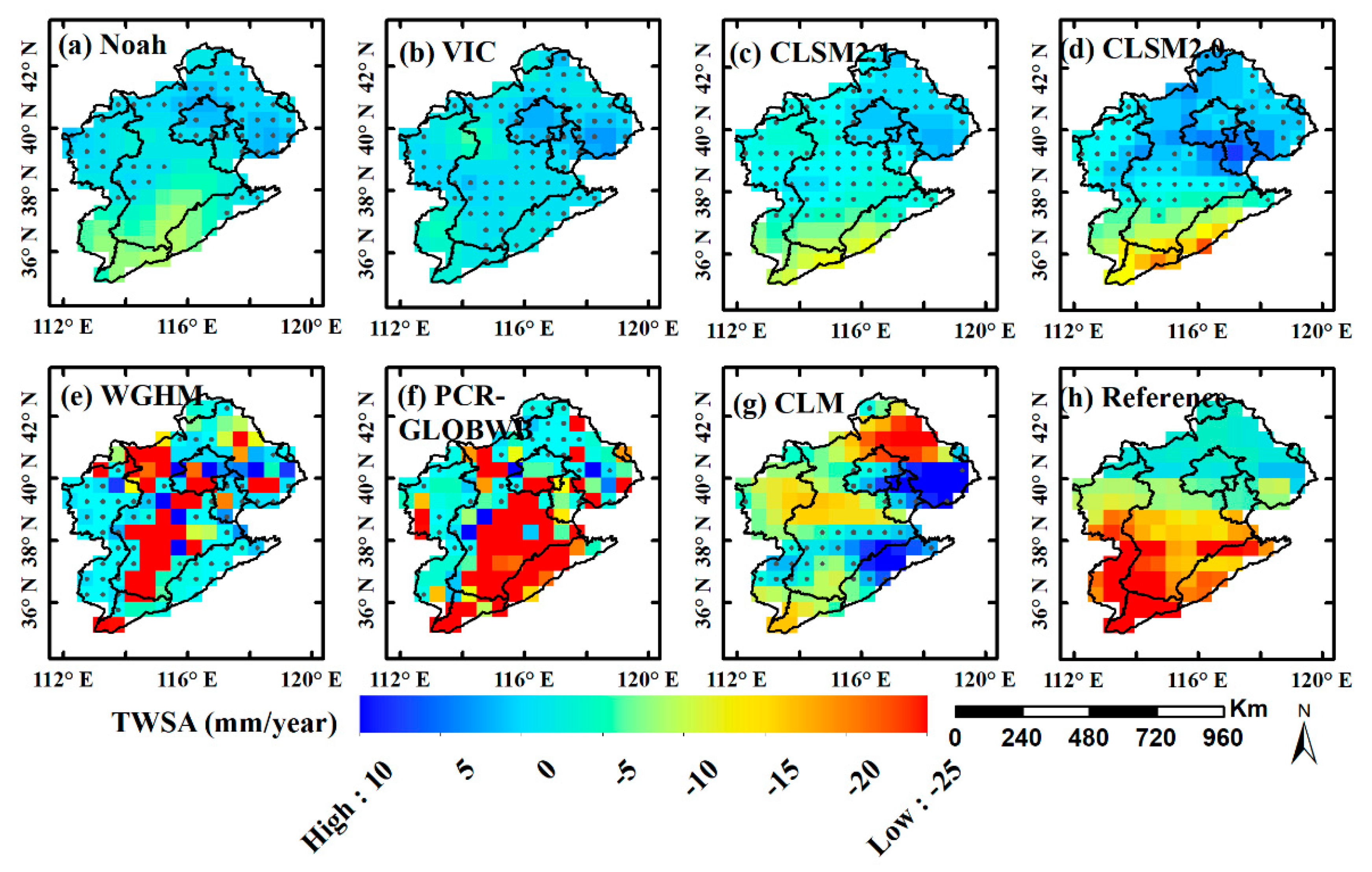
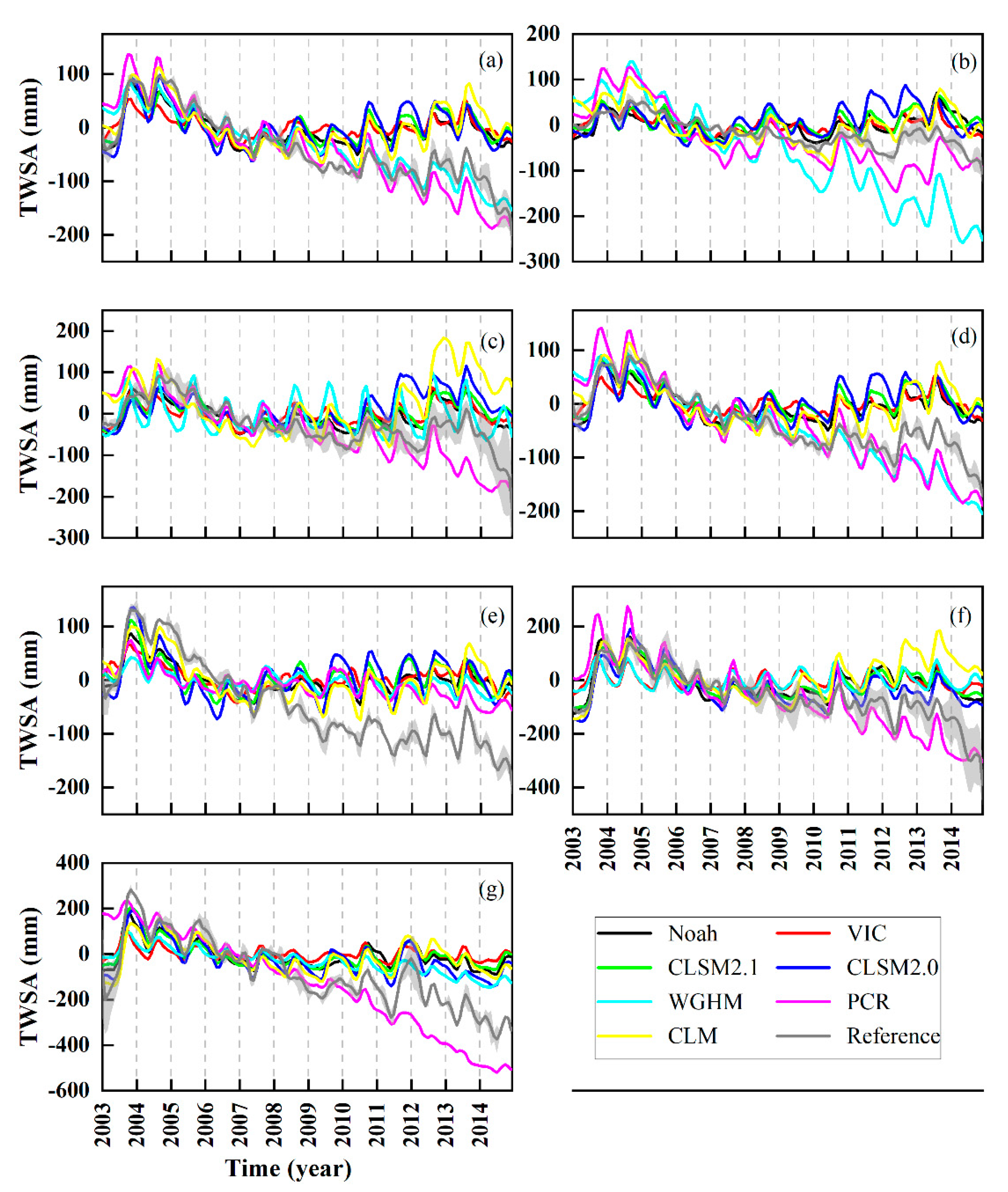

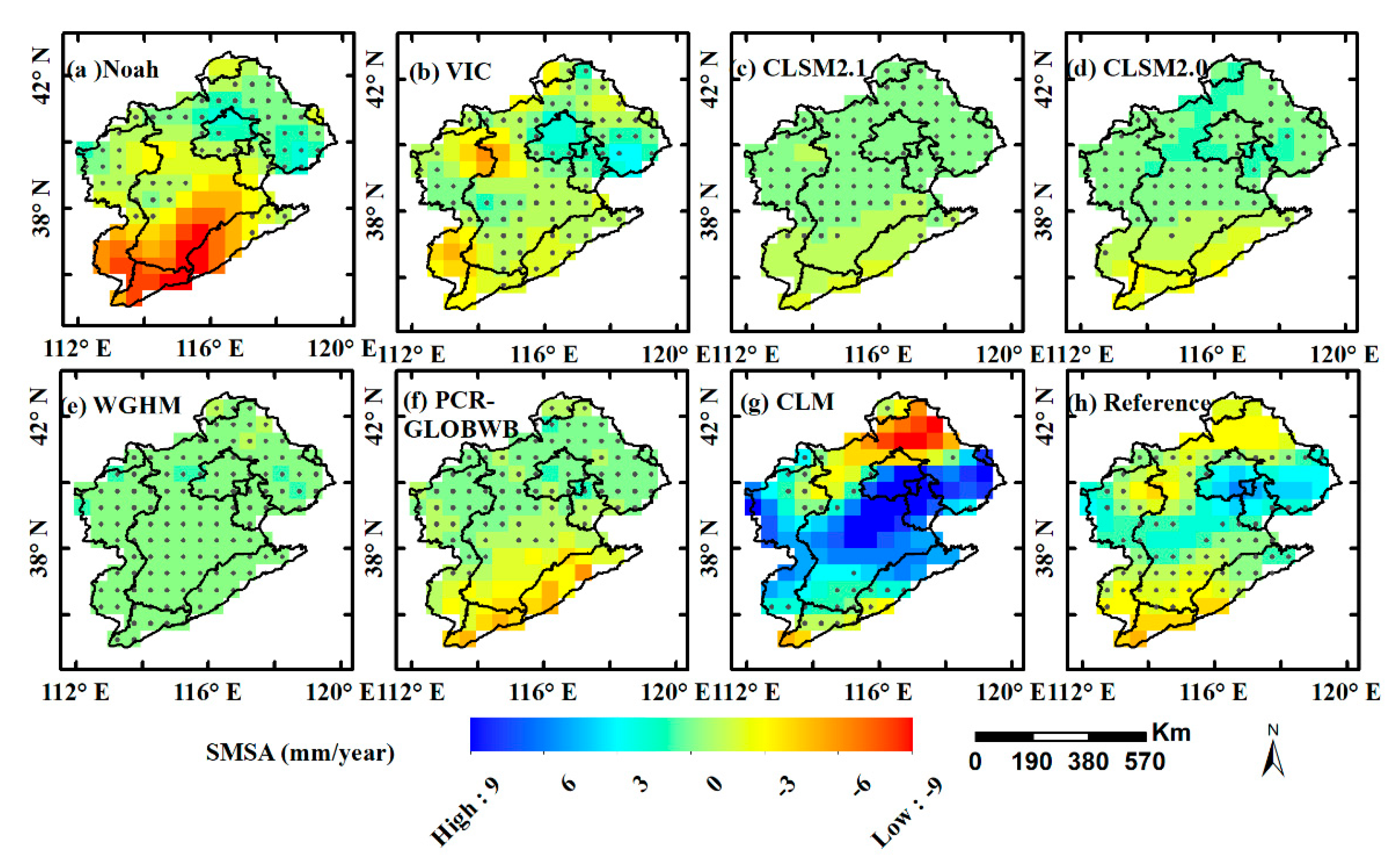

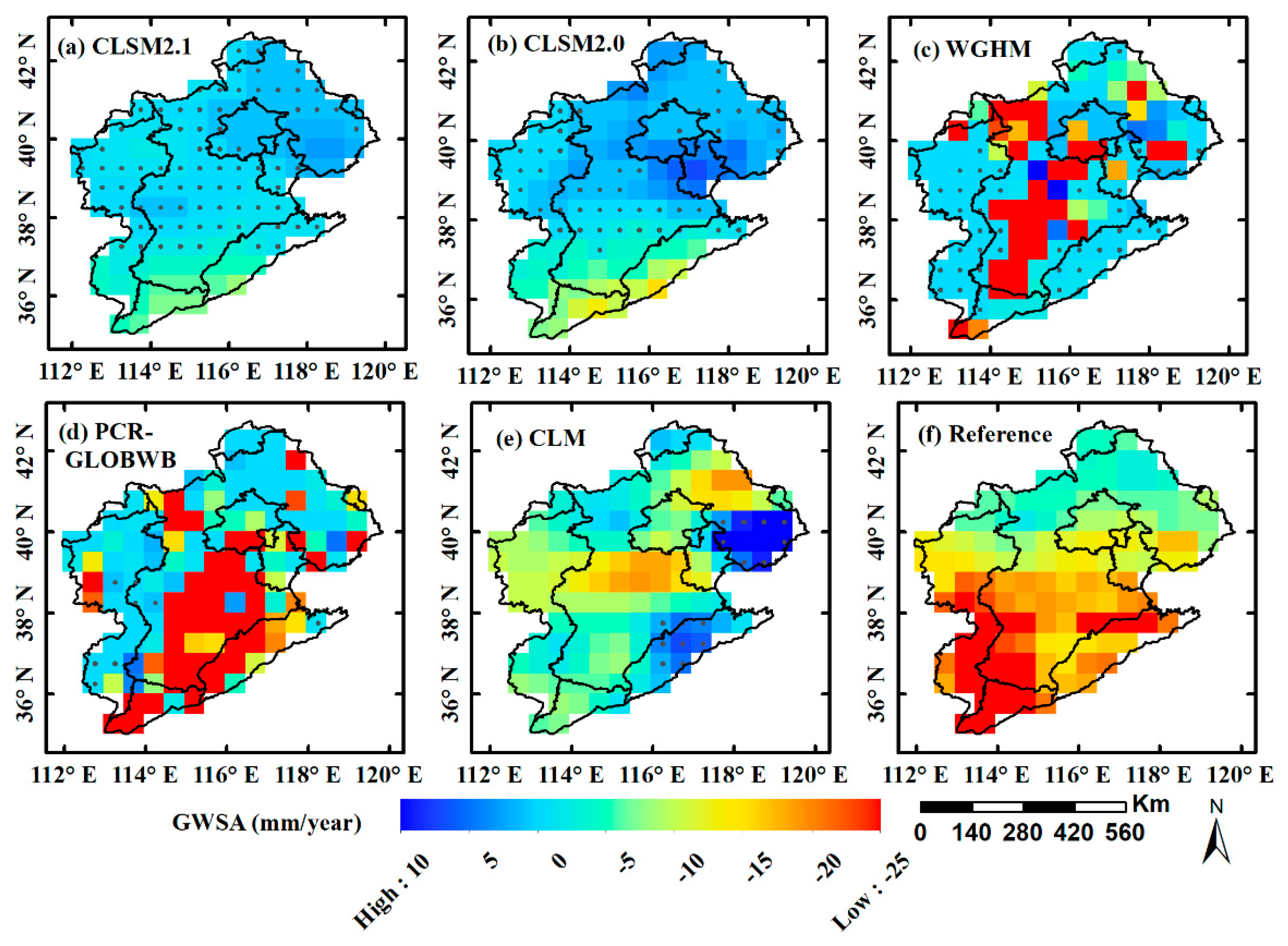
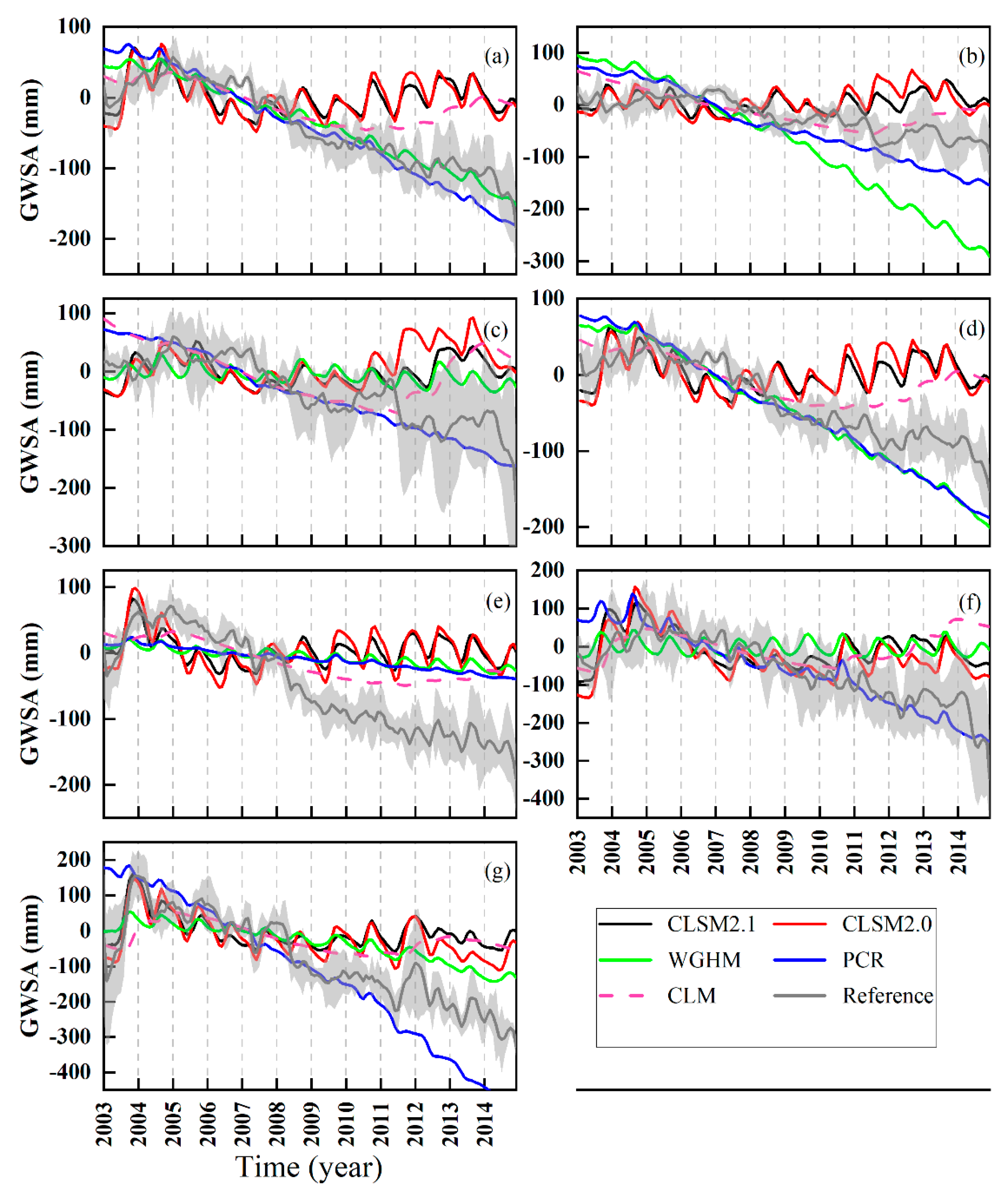

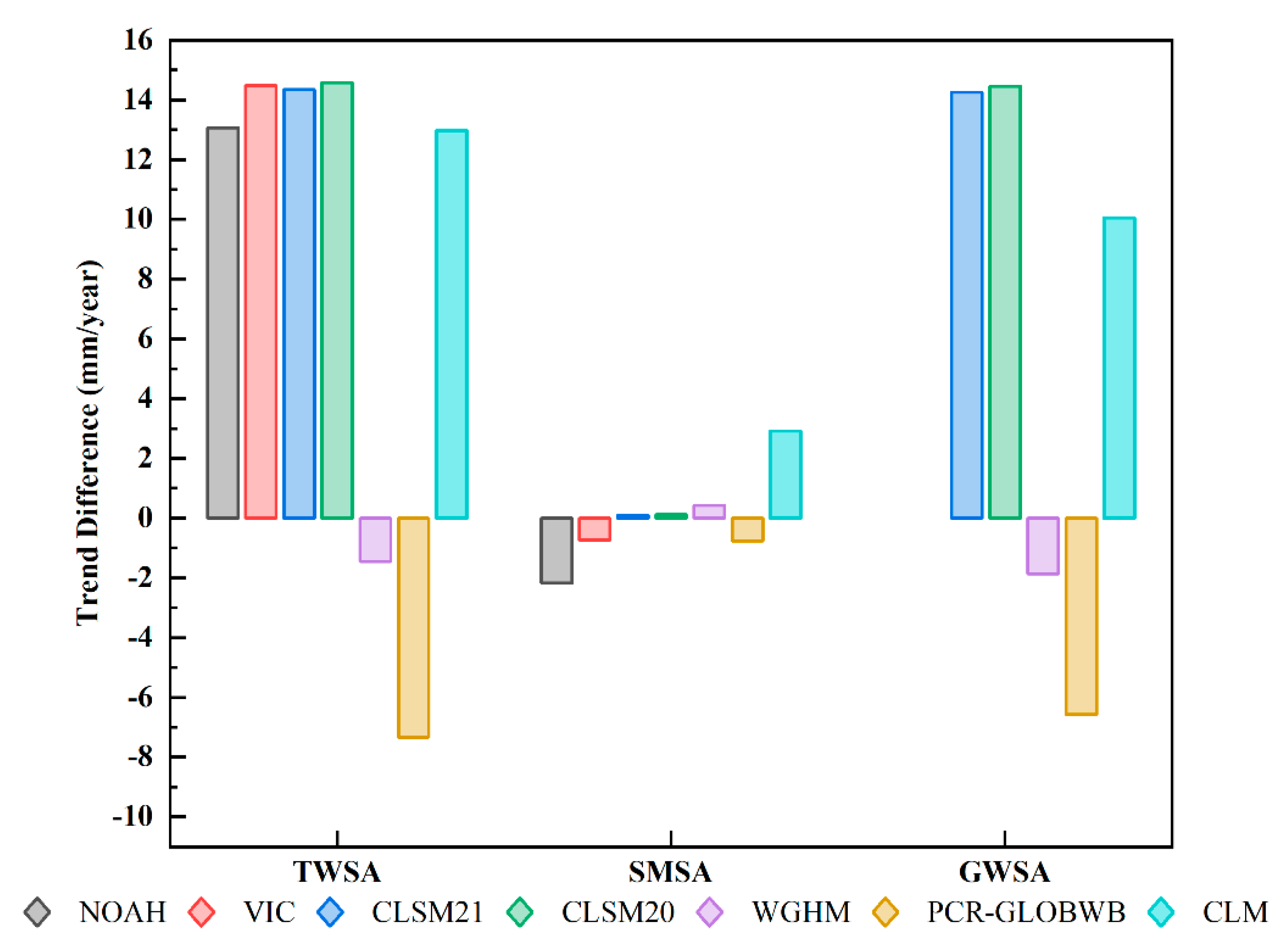
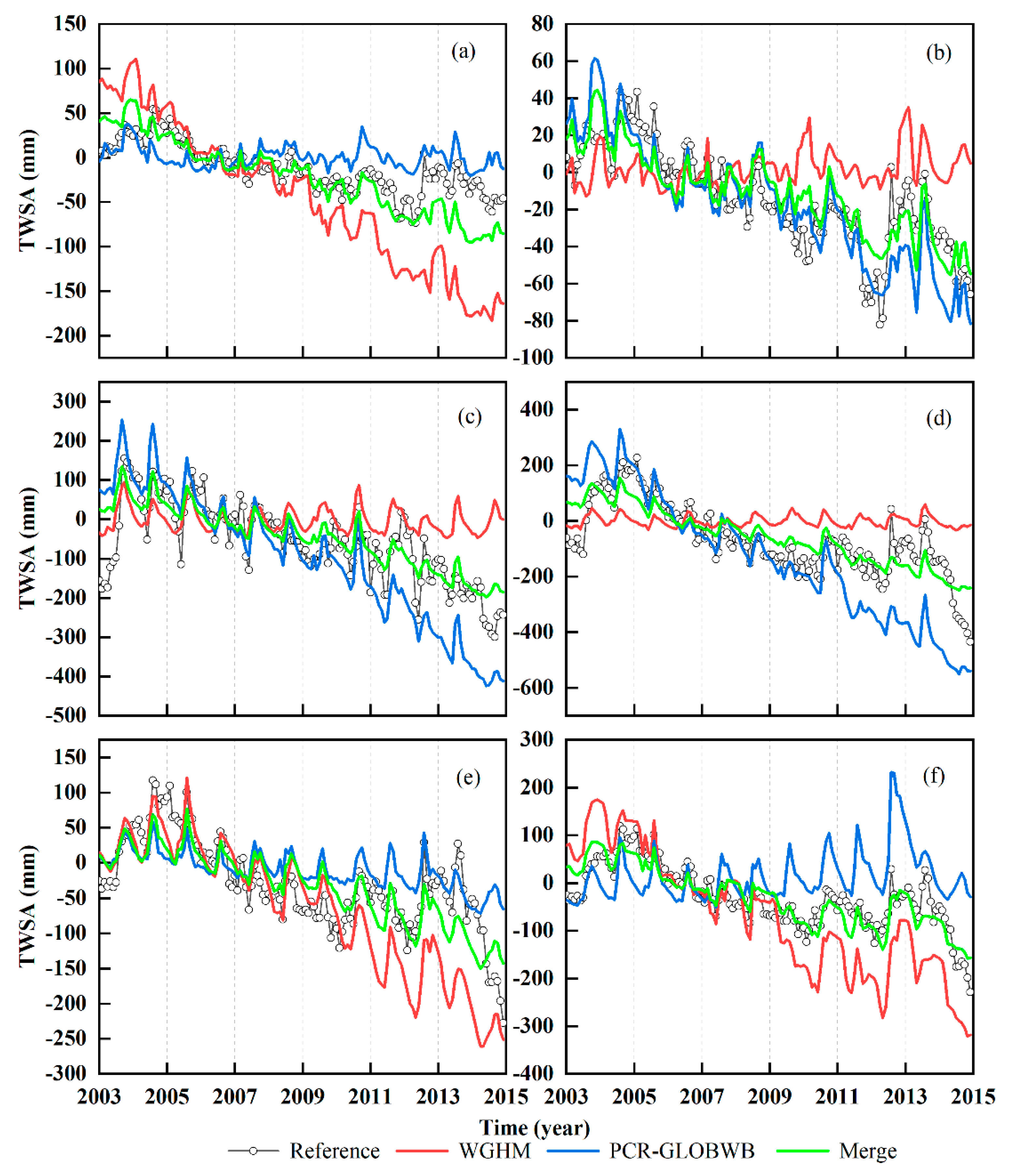
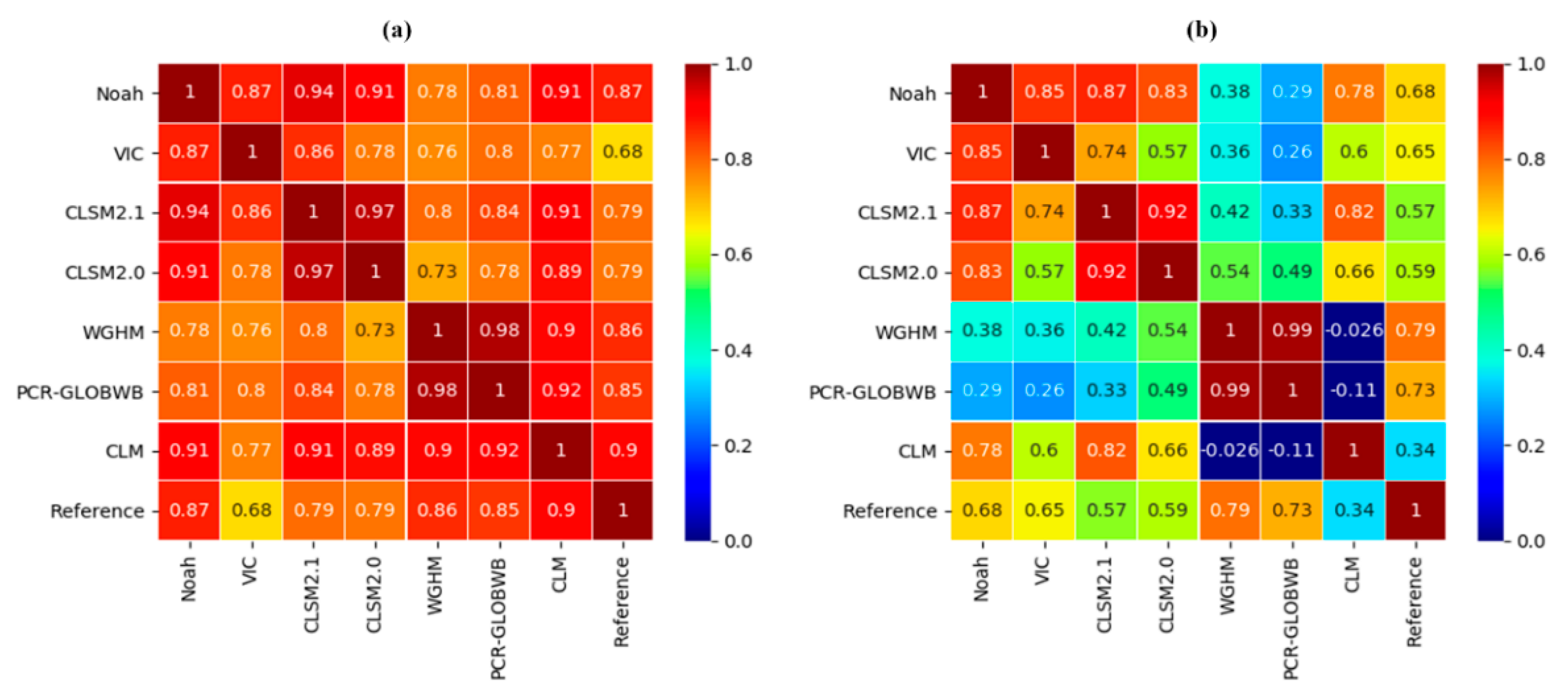
| Region | Area/km2 | Number of Grids | Region | Area/km2 | Number of Grids |
|---|---|---|---|---|---|
| Beijing | 17,000 | 10 | Plains | 130,000 | 50 |
| Tianjin | 12,000 | 7 | |||
| Hebei | 18,0000 | 76 | |||
| Shanxi | 61,000 | 28 | |||
| Shandong | 30,000 | 12 | Mountains | 199,000 | 95 |
| Henan | 15,000 | 8 | |||
| Liaoning | 1000 | 1 | |||
| Inner Mongolia | 13,000 | 5 | |||
| HRB (total) | 329,000 | 145 | HRB (total) | 329,000 | 145 |
| Description | Noah | VIC | CLSM2.1 | CLSM2.0 | WGHM | PCR-GLOBWB | CLM |
|---|---|---|---|---|---|---|---|
| Resolution | 1° × 1°; monthly | 1° × 1°; monthly | 1° × 1°; monthly | 0.25° × 0.25°; day | 0.5° × 0.5°; monthly | 0.08° × 0.08°; monthly | 0.94° × 1.25°; monthly |
| units | mm | mm | mm | mm | mm | m | mm |
| SnWS | √ | √ | √ | √ | √ | √ | √ |
| CWS | √ | √ | √ | √ | √ | √ | √ |
| SMS | √ | √ | √ | √ | √ | √ | √ |
| SWS | × | × | × | × | √ | √ | √ |
| GWS | × | × | √ | √ | √ | √ | √ |
| Soil layers | 4 | 3 | 1 | 1 | 1 | 2 | 10 |
| Human water use | × | × | × | × | √ | √ | × |
| Models | TWSA Trends | SMSA Trends | GWSA Trends |
|---|---|---|---|
| Noah | −2.6 ± 0.7 | −2.6 ± 0.7 | -- |
| VIC | −1.2 ± 0.5 | −1.2 ± 0.5 | -- |
| CLSM2.1 | −1.3 ± 0.7 | −0.3 ± 0.2 | −1.0 ± 0.6 |
| CLSM2.0 | −1.1 ± 0.9 | −0.3 ± 0.2 | −0.8 ± 0.7 |
| WGHM | −17.1 ± 0.4 | −0.1 ± 0.1 | −17.1 ± 0.2 |
| PCR-GLOBWB | −23.0 ± 0.7 | −1.2 ± 0.4 | −21.8 ± 0.2 |
| CLM | −2.7 ± 1.0 | 2.5 ± 0.8 | −5.2 ± 0.5 |
| Reference | −15.7 ± 0.7 | −0.4 ± 0.6 | −15.2 ± 0.9 |
| TWSA | SMSA | GWSA | |||||||
|---|---|---|---|---|---|---|---|---|---|
| RMSE mm | NSE | r | RMSE mm | NSE | r | RMSE mm | NSE | r | |
| Noah | 59.2 ± 9.1 | 0.13 ± 0.18 | 0.68 ± 0.01 | 12.0 ± 9.1 | 0.78 ± 0.26 | 0.94 ± 0.04 | -- | -- | -- |
| VIC | 67.5 ± 9.5 | 0.12 ± 0.18 | 0.52 ± 0.02 | 13.0 ± 5.1 | 0.75 ± 0.13 | 0.88 ± 0.02 | -- | -- | -- |
| CLSM2.1 | 66.6 ± 9.3 | 0.09 ± 0.19 | 0.52 ± 0.01 | 20.1 ± 5.5 | 0.39 ± 0.13 | 0.82 ± 0.00 | 70.6 ± 27.3 | 0.56 ± 0.88 | 0.16 ± 0.06 |
| CLSM2.0 | 67.1 ± 9.3 | 0.11 ± 0.18 | 0.49 ± 0.00 | 19.0 ± 5.8 | 0.46 ± 0.14 | 0.83 ± 0.01 | 71.7 ± 27.5 | 0.61 ± 0.86 | 0.14 ± 0.06 |
| WGHM | 26.0 ± 1.4 | 0.86 ± 0.01 | 0.91 ± 0.01 | 23.7 ± 5.3 | 0.15 ± 0.13 | 0.57 ± 0.02 | 20.7 ± 11.6 | 0.87 ± 0.13 | 0.94 ± 0.01 |
| PCR-GLOBWB | 34.9 ± 3.6 | 0.70 ± 0.09 | 0.91 ± 0.01 | 20.0 ± 7.7 | 0.40 ± 0.21 | 0.65 ± 0.03 | 30.4 ± 1.4 | 0.71 ± 0.06 | 0.94 ± 0.01 |
| CLM | 65.6 ± 10.4 | 0.06 ± 0.21 | 0.56 ± 0.03 | 18.3 ± 10.7 | 0.50 ± 0.71 | 0.91 ± 0.05 | 52.6 ± 26.2 | 0.13 ± 0.68 | 0.69 ± 0.01 |
| 2003–2009 | 2010–2014 | |||||||
|---|---|---|---|---|---|---|---|---|
| Grid | WGHM | PCR-GLOBWB | Merge | Reference | WGHM | PCR-GLOBWB | Merge | Reference |
| 1 | −23.5 ± 1.0 | −1.7 ± 1.0 | −12.0 ± 0.2 | −8.7 ± 0.2 | −23.8 ± 1.3 | −2.4 ± 1.1 | −12.1 ± 1.0 | −12.7 ± 0.1 |
| 2 | −1.2 ± 0.1 | −8.3 ± 1.2 | −5.0 ± 0.4 | −7.1 ± 0.1 | −1.5 ± 1.2 | −9.7 ± 2.5 | −6.0 ± 1.0 | −6.1 ± 0.1 |
| 3 | −1.1 ± 0.4 | −38.7 ± 2.1 | −17.1 ± 1.4 | −12.5 ± 1.3 | −2.4 ± 1.2 | −66.2 ± 3.8 | −30.2 ± 1.0 | −40.2 ± 2.0 |
| 4 | 1.3 ± 0.5 | −65.5 ± 2.5 | −28.0 ± 2.3 | −35.0 ± 2.1 | 1.0 ± 0.1 | −75.1 ± 3.0 | −33.7 ± 1.1 | −26.6 ± 2.2 |
| 5 | −13.0 ± 0.4 | −4.4 ± 1.3 | −8.2 ± 1.7 | −17.1 ± 1.4 | −29.1 ± 3.7 | −9.7 ± 1.0 | −17.8 ± 2.2 | −17.1 ± 1.0 |
| 6 | −38.1 ± 1.9 | 2.0 ± 0.1 | −18.2 ± 2.5 | −18.1 ± 1.5 | −15.0 ± 1.2 | −1.5 ± 0.2 | −7.6 ± 1.1 | −11.1 ± 1.4 |
| RMSE (mm) | NSE | r | |||||||
|---|---|---|---|---|---|---|---|---|---|
| Merge | WGHM | PCR-GLOBWB | Merge | WGHM | PCR-GLOBWB | Merge | WGHM | PCR-GLOBWB | |
| 1 | 17.4 ± 7.7 | 36.1 ± 15.4 | 22.1 ± 5.1 | 0.43 ± 0.19 | 1.67 ± 0.33 | 0.01 ± 0.01 | 0.82 ± 0.00 | 0.82 ± 0.01 | 0.29 ± 0.02 |
| 2 | 15.5 ± 7.3 | 21.3 ± 6.5 | 17.0 ± 5.5 | 0.46 ± 0.20 | 0.14 ± 0.09 | 0.29 ± 0.05 | 0.71 ± 0.01 | 0.22 ± 0.00 | 0.71 ± 0.01 |
| 3 | 67.7 ± 8.3 | 73.7 ± 8.9 | 85.0 ± 29.0 | 0.32 ± 0.21 | 0.20 ± 0.06 | −0.08 ± 0.06 | 0.60 ± 0.01 | 0.47 ± 0.01 | 0.57 ± 0.01 |
| 4 | 71.3 ± 9.4 | 108.5 ± 8.9 | 9.2 ± 41.5 | 0.58 ± 0.01 | 0.34 ± 0.08 | 0.30 ± 0.13 | 0.81 ± 0.02 | 0.21 ± 0.01 | 0.81 ± 0.02 |
| 5 | 26.3 ± 15.5 | 30.6 ± 9.7 | 44.0 ± 20.7 | 0.76 ± 0.09 | 0.70 ± 0.52 | 0.33 ± 0.04 | 0.84 ± 0.02 | 0.84 ± 0.02 | 0.65 ± 0.01 |
| 6 | 32.2 ± 5.1 | 57.6 ± 21.8 | 55.8 ± 26.7 | 0.67 ± 0.21 | 0.07 ± 0.09 | 0.00 ± 0.01 | 0.83 ± 0.02 | 0.82 ± 0.01 | 0.31 ± 0.00 |
| RMSE (mm) | NSE | r | |||||||
|---|---|---|---|---|---|---|---|---|---|
| Merge | WGHM | PCR-GLOBWB | Merge | WGHM | PCR-GLOBWB | Merge | WGHM | PCR-GLOBWB | |
| 1 | 35.6 ± 11.3 | 96.4 ± 63.5 | 36.4 ± 21.1 | 0.19 ± 0.78 | 4.04 ± 0.07 | −3.34 ± 1.51 | 0.61 ± 0.00 | 0.33 ± 0.01 | 0.60 ± 0.01 |
| 2 | 16.4 ± 15.2 | 45.2 ± 23.7 | 21.5 ± 9.2 | 0.29 ± 0.11 | −4.21 ± 1.31 | −0.19 ± 0.02 | 0.61 ± 0.01 | 0.44 ± 0.01 | 0.59 ± 0.02 |
| 3 | 67.5 ± 12.3 | 73.3 ± 26.7 | 85.4 ± 34.2 | 0.32 ± 0.14 | 0.20 ± 0.01 | −0.08 ± 0.04 | 0.60 ± 0.01 | 0.47 ± 0.01 | 0.57 ± 0.00 |
| 4 | 76.2 ± 16.3 | 17.6 ± 77.6 | 215.7 ± 91.7 | 0.37 ± 0.08 | −2.36 ± 0.94 | −4.02 ± 0.89 | 0.61 ± 0.02 | 0.57 ± 0.02 | 0.58 ± 0.01 |
| 5 | 45.1 ± 18.4 | 103.5 ± 41.2 | 61.8 ± 22.5 | 0.24 ± 0.07 | −3.00 ± 1.44 | −0.43 ± 0.08 | 0.57 ± 0.01 | 0.56 ± 0.01 | 0.52 ± 0.01 |
| 6 | 34.2 ± 9.8 | 120.1 ± 52.9 | 119.3 ± 78.6 | 0.58 ± 0.07 | −4.27 ± 2.13 | −4.23 ± 1.85 | 0.82 ± 0.01 | 0.82 ± 0.02 | 0.58 ± 0.01 |
Publisher’s Note: MDPI stays neutral with regard to jurisdictional claims in published maps and institutional affiliations. |
© 2021 by the authors. Licensee MDPI, Basel, Switzerland. This article is an open access article distributed under the terms and conditions of the Creative Commons Attribution (CC BY) license (https://creativecommons.org/licenses/by/4.0/).
Share and Cite
Wang, Q.; Zheng, W.; Yin, W.; Kang, G.; Zhang, G.; Zhang, D. Improving the Accuracy of Water Storage Anomaly Trends Based on a New Statistical Correction Hydrological Model Weighting Method. Remote Sens. 2021, 13, 3583. https://doi.org/10.3390/rs13183583
Wang Q, Zheng W, Yin W, Kang G, Zhang G, Zhang D. Improving the Accuracy of Water Storage Anomaly Trends Based on a New Statistical Correction Hydrological Model Weighting Method. Remote Sensing. 2021; 13(18):3583. https://doi.org/10.3390/rs13183583
Chicago/Turabian StyleWang, Qingqing, Wei Zheng, Wenjie Yin, Guohua Kang, Gangqiang Zhang, and Dasheng Zhang. 2021. "Improving the Accuracy of Water Storage Anomaly Trends Based on a New Statistical Correction Hydrological Model Weighting Method" Remote Sensing 13, no. 18: 3583. https://doi.org/10.3390/rs13183583
APA StyleWang, Q., Zheng, W., Yin, W., Kang, G., Zhang, G., & Zhang, D. (2021). Improving the Accuracy of Water Storage Anomaly Trends Based on a New Statistical Correction Hydrological Model Weighting Method. Remote Sensing, 13(18), 3583. https://doi.org/10.3390/rs13183583







